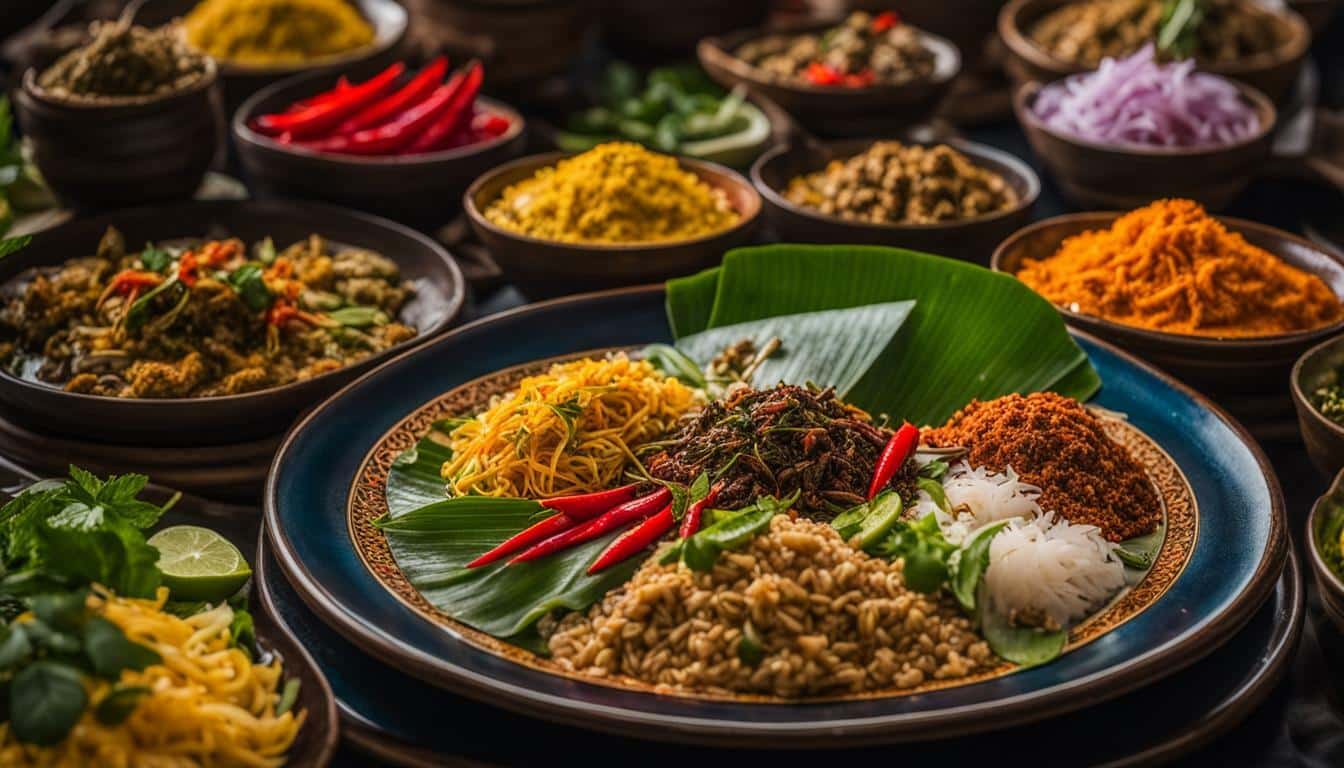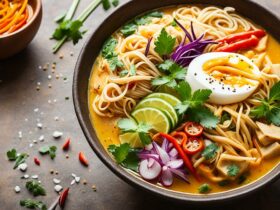Thai cuisine has taken the global culinary scene by storm, with its vibrant flavors and unique blend of sweet, sour, spicy, and salty. But what makes Thai food so popular? From the use of fresh ingredients and aromatic spices to the art of food presentation, Thai cuisine has a lot to offer. Let’s take a closer look at the factors that have contributed to the worldwide appeal of Thai food.
Key Takeaways:
- Thai food’s popularity is due to its distinctive and delicious flavor profile
- The use of fresh ingredients and bold spices is a key factor in creating authentic Thai dishes
- The art of food presentation adds to the visual appeal of Thai cuisine
- Thai street food is a cultural and culinary adventure
- Thai food reflects the traditions and values of Thai society, contributing to its global success
The Rich History and Culinary Traditions of Thai Cuisine
Thai cuisine is world-renowned for its unique blend of flavors and techniques that have been perfected over centuries. The popularity of Thai cuisine can be attributed to its rich history and cultural significance, as well as its delicious and diverse array of dishes.
The origins of Thai cuisine can be traced back to the early 13th century, influenced by neighboring countries such as India, China, and Vietnam. Over time, Thai cuisine has evolved to incorporate various ingredients and cooking methods to create a distinct flavor profile that is loved by millions around the world.
The Influence of Neighboring Countries
India, China, and Vietnam all played a major role in shaping Thai cuisine as it is known today. Indian traders introduced spices such as cumin and coriander, while Chinese immigrants brought their stir-frying techniques and introduced noodles and soy sauce.
Vietnamese influence is evident in the use of fresh herbs and vegetables, particularly in popular dishes like salads and spring rolls. Khao man gai, a famous Thai dish made with boiled chicken and rice, is believed to have originated from Hainanese chicken rice in China.
Evolution of Thai Dishes
Thai cuisine has continued to evolve over time, incorporating new ingredients and techniques to create a range of dishes that cater to different taste preferences. For instance, the popular green curry paste was originally created with Indian spices, but has since been modified to include Thai ingredients such as lemongrass, galangal, and kaffir lime.
Other popular Thai dishes like tom yum soup and pad Thai have also undergone their own transformations, adapting to changing tastes and preferences over the years.
The worldwide popularity of Thai cuisine is a testament to the rich history and culinary traditions that continue to inspire and delight food lovers around the globe.
The Perfect Harmony of Sweet, Sour, Spicy, and Salty
One of the main reasons why Thai food is loved around the world is because of the distinctive blend of flavors that come together in each dish. Thai cuisine boasts a perfect balance of sweet, sour, spicy, and salty flavors that create a unique and unforgettable taste experience.
The combination of these flavors is so beloved that it has even been referred to as the “holy trinity” of Thai cuisine. This flavor profile appeals to a wide range of taste preferences and creates a harmonious balance that is both satisfying and delicious.
Whether it’s the heat of a spicy tom yum soup, the sweetness of mango sticky rice, or the tanginess of a green papaya salad, Thai cuisine offers a flavor experience like no other.
This perfect harmony of flavors is one of the key factors that contribute to the global appeal of Thai food. It has become a culinary craze that is enjoyed by people from all walks of life all around the world.
The Key to Thai Flavors: Fresh Ingredients and Bold Spices
Thai cuisine is renowned for its bold flavors and unique blend of ingredients, which have contributed to the craze and popularity of Thai food globally. One of the reasons why Thai food is loved is its emphasis on using fresh, locally sourced ingredients and aromatic spices to create memorable dishes.
The importance of fresh ingredients cannot be overstated in Thai cooking. Thai chefs pride themselves on using only the freshest produce, meat, and seafood to create dishes that burst with flavor. This emphasis on freshness ensures that the natural flavors of the ingredients are enhanced, resulting in dishes that are both delicious and healthy.
Another key component of Thai cuisine is the use of bold spices. Thai dishes are known for their spicy and aromatic flavors, which are created using a variety of spices such as chili peppers, garlic, ginger, and lemongrass. These herbs and spices not only add flavor, but also have medicinal properties that are beneficial for health.
The use of fish sauce, a pungent and salty condiment made from fermented fish, is another signature element of Thai cuisine. It is used as a seasoning in many Thai dishes, adding a distinct umami flavor that enhances the taste of the dish.
The combination of fresh ingredients and bold spices is what makes Thai food popular among foodies and casual diners alike. Not only does it produce delicious and healthy dishes, but it also creates a unique and unforgettable dining experience that keeps customers coming back for more.
The Art of Thai Food Presentation
Thai cuisine is not just about flavor and aroma; it’s also a feast for the eyes. The art of Thai food presentation is a meticulous process that elevates dining to a visual masterpiece.
One of the key aspects of Thai food presentation is the use of vibrant colors. From green herbs to red chilies, yellow curries to orange shrimp, Thai dishes are a spectrum of hues that stimulate the appetite. The colors are often carefully chosen to create a balance between hot and cool tones, representing the yin and yang of Thai cuisine.
The use of decorative serving platters and intricate garnishes is also an integral part of Thai food presentation. The presentation of a dish is just as important as its taste: a beautiful plate can make all the difference in creating a memorable dining experience.
Thai chefs are skilled in the art of carving fruits and vegetables into intricate shapes, adding a touch of playfulness to their dishes. For example, a carrot can be carved into a flower, a cucumber into a swan, or a watermelon into an intricate design. When it comes to garnishes, Thai cuisine takes it to the next level with edible flowers, banana leaves, and even gold leaf.
The visual appeal of Thai food has contributed to its craze and global appeal. People are not just looking for delicious food; they also want a dining experience that stimulates all their senses. Thai cuisine delivers on both fronts with its exquisite blend of flavor and presentation.
Thai Street Food: A Culinary Adventure
When it comes to the popularity of Thai cuisine, it’s impossible to overlook the thriving street food culture in Thailand. From the bustling streets of Bangkok to the peaceful beaches of Phuket, the aroma of sizzling meats and simmering curries fills the air, drawing in hungry locals and tourists alike.
One of the reasons why Thai street food is so beloved is its accessibility and affordability. Unlike high-end restaurants, street food stalls and carts offer a wide range of dishes at budget-friendly prices, making it easy for everyone to enjoy the flavors of Thailand.
But it’s not just about the price. Thai street food is a culinary adventure, offering a diverse range of flavors and textures that tantalize the taste buds. From crispy fried chicken to creamy coconut milk desserts, there’s something for everyone to discover and savor.
Another factor that makes Thai street food so popular is its authenticity. Many street food vendors use traditional recipes and cooking methods that have been passed down for generations, ensuring that every bite is a true taste of Thai culture.
Whether you’re in the mood for something savory like pad thai or something sweet like mango sticky rice, Thai street food is a must-try for any food lover. So next time you find yourself strolling through the vibrant streets of Thailand, be sure to follow your nose and indulge in the culinary delights of Thai street food.
The Influence of Thai Culture on Food
Thai cuisine is not only revered for its delicious flavors and unique ingredients but also for reflecting the country’s vibrant culture and traditions. The popularity of Thai food can be attributed to the cultural significance of food in Thai society.
Communal dining and the sharing of food are integral parts of Thai culture, where meals are meant to be enjoyed with family and friends. This emphasis on hospitality and togetherness has helped Thai cuisine gain worldwide popularity, as it resonates with people around the globe.
Thai cuisine is also heavily influenced by the country’s geography, history, and neighboring cultures. The blending of these cultures has led to the creation of diverse and flavorful dishes that are enjoyed worldwide.
The use of fresh herbs and spices is also a reflection of Thai culture’s emphasis on health and wellness. Thai cuisine typically includes ingredients like lemongrass, galangal, and turmeric, which are believed to have medicinal properties and are used in many traditional Thai remedies.
Overall, the cultural significance of Thai food has played a crucial role in its worldwide popularity. From the communal dining experience to the use of fresh and healthy ingredients, Thai cuisine reflects the values and traditions of Thai society, making it a cuisine that is adored by many and will continue to be enjoyed for generations to come.
Conclusion
In conclusion, Thai food has gained worldwide popularity due to its rich history, unique blend of flavors and techniques, and cultural significance. The perfect harmony of sweet, sour, spicy, and salty, along with the use of fresh ingredients and bold spices, contribute to the distinctive taste of Thai cuisine. The art of food presentation and the accessibility of Thai street food also play a role in its global appeal.
Additionally, the influence of Thai culture on food, with its emphasis on hospitality, communal dining, and sharing of food, has helped Thai cuisine gain popularity worldwide.
Overall, Thai food’s enduring appeal can be attributed to its delicious taste, cultural significance, and ability to cater to a wide range of taste preferences. It’s no wonder why Thai food is so popular and continues to be a favorite among food enthusiasts worldwide.
FAQ
What makes Thai food so popular worldwide?
Thai food’s popularity can be attributed to its vibrant flavors, unique blend of sweet, sour, spicy, and salty, and the use of fresh ingredients and bold spices. Additionally, the cultural significance of Thai cuisine and the art of food presentation play a role in its global appeal.
Why is Thai street food so loved?
Thai street food is loved for its accessibility, affordability, and diverse range of flavors. It offers a culinary adventure with its various dishes and is a favorite among both locals and tourists.
How does Thai cuisine reflect Thai culture?
Thai cuisine reflects Thai culture through the importance of hospitality, communal dining, and the sharing of food. These cultural values have helped Thai cuisine gain popularity worldwide.
What are the key factors behind the popularity of Thai cuisine?
The key factors behind the popularity of Thai cuisine include its rich history and culinary traditions, the perfect harmony of sweet, sour, spicy, and salty flavors, the use of fresh ingredients and bold spices, the art of food presentation, and the influence of Thai culture on food.





